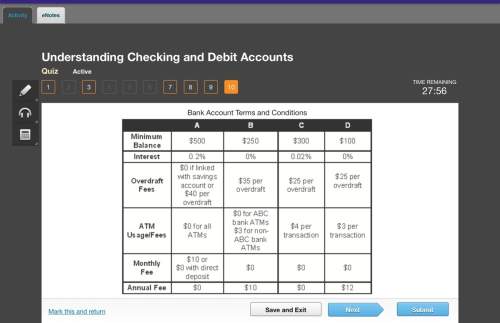
Business, 18.11.2019 20:31 jakaylathomas11
Suppose the risk-free rate is 8%. the expected return on the market is 14%. given this data, answer the following questions: if a particular stock has a beta of .6, what is its expected return based on the capm? if another stock has an expected return of 20%, what must its beta be? if a stock has a beta of 1.3 and a current return of 17%, what can you say about the stock’s current price? what direction would you expect the stock price to move?

Answers: 2
Another question on Business

Business, 22.06.2019 04:40
Select the correct text in the passage.which sentences in the given passage explains the limitations of monetary policies? monetary policies - limitationsmonetary policies are set by the central bank to bring about growth in the economy.de can be achieved these policiesw at anden i sca poit would be fair to say that changes in the economy cannot be brought about instantly by monetary po des.monetary policy can only influence not control, economic growththe monetary policy makers do work on sining the perfect balance between demand and supply of money in the economy
Answers: 3

Business, 22.06.2019 08:40
Which of the following statements is true regarding the reporting of outside interests and the management of conflicts? investigators are responsible for developing their own management plans for significant financial interests. the institution must report identified financial conflicts of interest to the u.s. office of research integrity. investigators must disclose their significant financial interests related to their institutional responsibilities and not just those related to a particular project. investigators must disclose all of their financial interests regardless of whether they are related to a research project.
Answers: 3

Business, 22.06.2019 15:40
As sales exceed the break‑even point, a high contribution‑margin percentage (a) increases profits faster than does a low contribution-margin percentage (b) increases profits at the same rate as a low contribution-margin percentage (c) decreases profits at the same rate as a low contribution-margin percentage (d) increases profits slower than does a low contribution-margin percentage
Answers: 1

Business, 22.06.2019 16:00
Arnold rossiter is a 40-year-old employee of the barrington company who will retire at age 60 and expects to live to age 75. the firm has promised a retirement income of $20,000 at the end of each year following retirement until death. the firm's pension fund is expected to earn 7 percent annually on its assets and the firm uses 7% to discount pension benefits. what is barrington's annual pension contribution to the nearest dollar for mr. rossiter? (assume certainty and end-of-year cash flows.)
Answers: 2
You know the right answer?
Suppose the risk-free rate is 8%. the expected return on the market is 14%. given this data, answer...
Questions


Social Studies, 09.07.2019 07:50



Social Studies, 09.07.2019 07:50


Mathematics, 09.07.2019 07:50


Health, 09.07.2019 07:50



Social Studies, 09.07.2019 07:50

History, 09.07.2019 07:50

Mathematics, 09.07.2019 07:50

Biology, 09.07.2019 07:50

Mathematics, 09.07.2019 07:50

Social Studies, 09.07.2019 07:50

Biology, 09.07.2019 07:50

Biology, 09.07.2019 07:50

History, 09.07.2019 07:50




